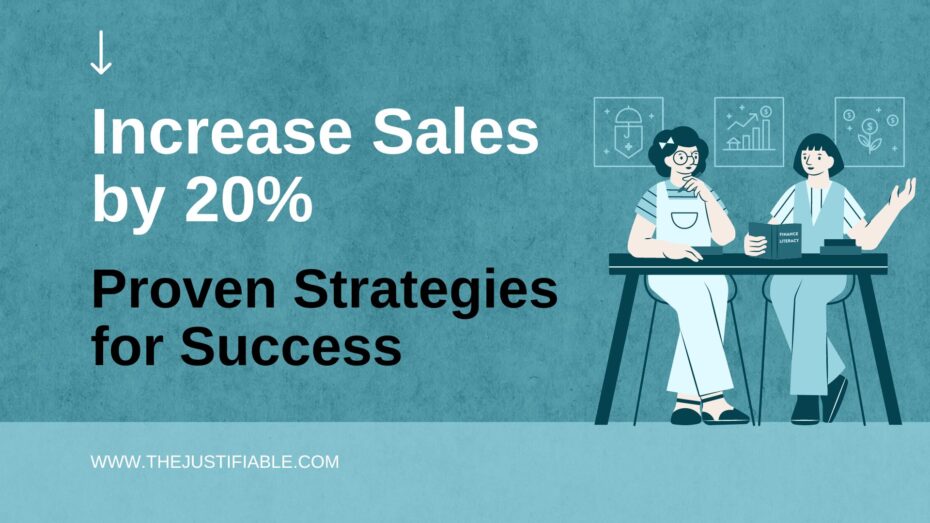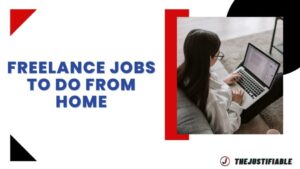Increasing sales is the heartbeat of every business’s growth and sustainability. In a world where competition is fierce and customer expectations are ever-evolving, unlocking the potential to boost your sales figures is not just a goal; it’s a necessity for survival and success.
This article dives into the core of what it takes to elevate your sales by a significant 20%, transforming challenges into opportunities and strategies into tangible results.
At the heart of this endeavor is understanding the multifaceted nature of sales enhancement. It’s not merely about pushing more products or services; it’s about crafting an experience that resonates with your customers, leveraging the right tools, and adopting a mindset that thrives on innovation and adaptation.
By integrating proven techniques with cutting-edge insights, we aim to provide you with a comprehensive guide that not only aims to increase sales but does so in a way that aligns with the evolving landscape of consumer behavior and market trends.
Analyzing Your Current Sales Performance: Key Data Insights
In the quest to increase sales, understanding where you currently stand is not just helpful; it’s fundamental. Think of it as setting the GPS before embarking on a journey. You need to know your starting point to navigate effectively to your destination. Analyzing your current sales performance offers this critical insight, serving as a compass guiding your business strategies towards growth and success.
Delving into your sales metrics is like having an honest conversation with your business. It’s about asking tough questions: What’s working? What isn’t? Where are the opportunities for improvement? This analysis isn’t just about crunching numbers; it’s a strategic approach to uncovering the story behind those numbers. It’s about discerning patterns, understanding customer behaviors, and identifying market trends.
Imagine this: By closely examining your sales data, you could uncover that a particular product line performs exceptionally well during certain months. Or, you might find that specific marketing channels are bringing in more high-value customers. These insights are goldmines for informed decision-making. They enable you to tailor your strategies, allocate resources more effectively, and ultimately, boost your sales performance.
Moreover, in today’s digital age, where data is abundant, leveraging analytical tools to understand your sales metrics can give you a competitive edge. These tools can provide comprehensive dashboards, predictive analytics, and customer insights, which are invaluable in crafting targeted strategies to increase sales.
Remember, improving sales is not about taking wild stabs in the dark; it’s about making data-driven decisions. By analyzing your current sales performance, you are laying a solid foundation upon which sustainable growth can be built. This approach not only helps in fine-tuning your current strategies but also in foreseeing future opportunities, ensuring that your business remains agile and responsive in an ever-changing marketplace.
Top 5 High-Impact Techniques to Boost Sales Effectively
In the dynamic world of business, the quest to increase sales is a constant. Yet, amidst the plethora of advice and strategies, certain techniques stand out for their proven effectiveness and high impact. Let’s explore five such strategies that have consistently helped businesses elevate their sales and achieve remarkable growth.
- Personalization is the New Gold Standard: In a market flooded with options, personalization is your secret weapon to stand out. Tailoring your approach to meet the specific needs and preferences of your customers can dramatically boost sales. It’s about showing your customers that you understand and value their unique requirements, whether it’s through customized products, personalized emails, or targeted offers. This level of attention not only enhances customer experience but also fosters loyalty, leading to repeat purchases and referrals.
- Leverage the Power of Social Proof: In the digital age, social proof has emerged as a powerful tool to increase sales. Customer reviews, testimonials, social media shoutouts – these are modern-day word-of-mouth that can significantly sway buying decisions. Showcasing positive feedback from satisfied customers builds trust and credibility, encouraging others to make the leap from consideration to purchase.
- Refine Your Online Presence: With the digital landscape being a primary battleground for sales, having a strong online presence is paramount. This goes beyond just having a website or social media profiles. It’s about optimizing your online touchpoints – from SEO-friendly content that draws in potential customers to a user-friendly website that provides a seamless shopping experience. An engaging online presence can be a major driver in boosting your sales figures.
- Upselling and Cross-Selling with Finesse: These are time-tested strategies to increase the value of each customer interaction. Upselling involves encouraging customers to purchase a premium version of what they’re already buying, while cross-selling suggests complementary products. The key here is subtlety and relevance; offer upgrades or additional items that genuinely enhance the customer’s purchase.
- Invest in Customer Relationships: Last but definitely not the least, building and maintaining strong relationships with your customers can lead to sustained sales growth. This involves consistent communication, exceptional customer service, and listening to customer feedback. By investing in these relationships, you create a loyal customer base that not only continues to buy but also acts as advocates for your brand.
Each of these strategies is a cog in the wheel of your sales machinery. Implemented thoughtfully, they can work together to create a comprehensive approach that not only aims to increase sales but does so in a sustainable and customer-centric manner.
Harnessing Digital Marketing: A Power Move to Increase Sales
In today’s fast-paced digital world, harnessing the power of digital marketing is not just a smart move; it’s essential to increase sales and propel your business forward. Gone are the days when traditional marketing alone could carry the weight of your sales goals. The digital arena offers a plethora of tools and strategies that, when used effectively, can significantly boost your sales figures.
Firstly, let’s talk about the magic of Search Engine Optimization (SEO). SEO is the art and science of getting your website to rank higher in search engine results. Why is this important? Because higher visibility leads to more traffic, and more traffic leads to more potential sales. By optimizing your website with relevant keywords, quality content, and a user-friendly interface, you’re setting up a digital storefront that’s both inviting and accessible to your target audience.
Then, there’s the world of social media marketing. Platforms like Facebook, Instagram, and LinkedIn have transformed the way businesses connect with customers. These platforms are not just channels for promotion; they’re venues for building relationships. By engaging with your audience through regular posts, interactive content, and direct messaging, you can create a community around your brand. This not only increases brand awareness but also fosters loyalty, which is a key ingredient in boosting sales.
Email marketing is another powerful tool in the digital marketing arsenal. It’s personal, direct, and cost-effective. By sending tailored emails to different segments of your audience, you can promote products, share news, and offer exclusive deals. The beauty of email marketing lies in its ability to nurture leads and convert them into sales over time.
Pay-Per-Click (PPC) advertising is like the fast lane on the digital marketing highway. By placing ads on search engines and social media, you can target specific demographics, interests, and behaviors. The result? You get your brand in front of the right people at the right time, driving traffic and, ultimately, sales.
Lastly, content marketing should not be overlooked. This strategy involves creating valuable, relevant content to attract and engage your audience. Whether it’s through blog posts, videos, or infographics, good content can establish your brand as a thought leader in your industry, build trust with your audience, and subtly guide them towards making a purchase.
Leveraging Social Proof to Amplify Sales by 20%
In the journey to increase sales, one of the most persuasive tools at your disposal is social proof. Social proof, in the form of customer reviews, testimonials, and social media interactions, plays a pivotal role in shaping consumer decisions. It’s the digital equivalent of word-of-mouth and can be the deciding factor that tips the scales in your favor, potentially boosting your sales by an impressive 20% or more.
Let’s delve into the power of customer reviews first. Reviews act as a trust signal for potential buyers, offering an unbiased perspective on your products or services. When customers are contemplating a purchase, they often seek reassurance from others’ experiences. Positive reviews can significantly diminish the uncertainty surrounding a purchase decision, leading to a higher conversion rate. They are not just comments; they are validations of your product’s quality and effectiveness.
Testimonials serve a similar purpose but add a personal touch. Featuring detailed testimonials on your website or in your marketing material can create an emotional connection with prospective customers. It’s a way of showing that your product or service has not just fulfilled but exceeded customer expectations. Testimonials often tell a story, and stories are a powerful way to engage and persuade an audience.
Social media amplifies this effect by broadcasting customer satisfaction to a wider audience. Each like, share, or comment is an endorsement of your brand, contributing to a growing narrative about your product’s value. Social media platforms are also excellent for showcasing user-generated content, such as customer photos or videos using your product, adding authenticity and relatability to your brand.
It’s important to note that social proof extends beyond just showcasing positive feedback. It includes how you interact with customers online, respond to queries, and address concerns. This level of engagement not only fosters trust but also builds a community around your brand. A strong, positive online presence can turn customers into brand advocates, who then willingly share their positive experiences with others, thus creating a cycle that continually promotes and amplifies sales growth.
Streamlining the Sales Process with Smart Technology
In today’s digital era, integrating technology into your sales process is not just an option; it’s a necessity to stay competitive and increase sales. Smart technology has revolutionized how sales are conducted, providing tools and platforms that optimize each step of the sales journey, from lead generation to closing deals.
The role of technology in enhancing the sales process begins with the power of Customer Relationship Management (CRM) systems. These systems are not mere databases; they are the backbone of a strategic sales approach. A robust CRM system can track customer interactions, manage leads, and provide valuable insights into customer behavior and preferences. This level of insight enables sales teams to personalize their approach, engage more effectively with prospects, and close deals more efficiently.
But it doesn’t stop there. Automation tools have transformed mundane, repetitive tasks into streamlined, efficient processes. Imagine not having to manually send follow-up emails or schedule appointments. Automation tools can take care of these tasks, freeing up your sales team to focus on more strategic activities that directly contribute to increasing sales. This efficiency not only saves time but also ensures that no lead falls through the cracks.
Artificial Intelligence (AI) and Machine Learning are also playing a significant role in optimizing the sales process. AI-powered tools can analyze vast amounts of data to predict customer buying patterns, identify high-quality leads, and even recommend the best times to contact prospects. This isn’t just about making guesses; it’s about making informed, data-driven decisions that enhance the effectiveness of your sales efforts.
Moreover, technology has enabled the advent of digital sales channels, expanding the reach and accessibility of businesses. E-commerce platforms, mobile apps, and social media channels offer new avenues to showcase products and engage with customers. These platforms not only increase sales opportunities but also provide valuable customer data that can be used to refine sales strategies further.
Crafting Irresistible Offers: A Game-Changer in Sales Strategy
When it comes to boosting sales, the art of crafting irresistible offers is a game-changer. It’s not just about slashing prices or throwing in a freebie; it’s about creating value that resonates with your customers, compelling them to act. In the bustling marketplace where everyone is vying for attention, your offer needs to stand out, to speak directly to the needs and desires of your target audience.
One effective technique is to understand and tap into the psychology of your customers. What drives their purchasing decisions? Is it a quest for quality, a love for great deals, or a desire for exclusivity? For instance, limited-time offers create a sense of urgency, nudging customers to act quickly to avoid missing out. This tactic plays on the fear of missing out (FOMO) and can be incredibly effective in driving sales.
Another strategy is bundling products or services. This not only provides customers with more value but also encourages them to try products they might not have considered otherwise. A well-crafted bundle offer is not just a sales tactic; it’s a customer service gesture that says, “We’ve put together the perfect package for you.”
Personalization is also key in creating offers that drive sales. In an era where personalization is possible and expected, generic offers just don’t cut it anymore. Tailoring your offers based on customer data — like past purchases, browsing behavior, or demographic information — can make your customers feel understood and valued, increasing the likelihood of them making a purchase.
Loyalty programs are another powerful tool. They not only encourage repeat business but also create a sense of belonging to a community. A loyalty program that offers exclusive deals, points, or rewards for regular customers can turn occasional buyers into brand ambassadors.
Finally, the presentation of your offer is crucial. It’s not just what you offer; it’s how you communicate it. Your offer should be clear, concise, and compelling. It should be easy to understand and act upon. A great offer lost in a sea of words or hidden in fine print is an opportunity missed.
The Art of Upselling and Cross-Selling: Maximizing Every Transaction
Mastering the art of upselling and cross-selling is a key strategy in increasing the value of each customer purchase, ultimately leading to a substantial increase in sales. This approach is not about making a quick sale; it’s about enhancing the customer’s purchasing experience by offering additional value that they genuinely appreciate.
Upselling is the practice of encouraging customers to purchase a higher-end product than the one they are initially considering. It’s an art that revolves around understanding the customer’s needs and suggesting alternatives that provide more value or features. For instance, if a customer is considering a basic model of a product, introducing them to a premium version with compelling features can be an eye-opener. The trick here is to show the customer how the higher-priced item offers more benefits or is more cost-effective in the long run.
Cross-selling, on the other hand, involves recommending products that complement the initial purchase. This strategy is about creating a holistic shopping experience. For example, if a customer is buying a new smartphone, suggesting a protective case or a pair of high-quality earphones enhances the overall value of their purchase. Effective cross-selling requires a deep understanding of your product range and how different products can be combined to better serve the customer’s needs.
Both these strategies rely heavily on the sales team’s product knowledge and their ability to communicate benefits effectively. Training your team to understand customer needs and preferences can lead to more personalized and successful upselling and cross-selling efforts.It’s about listening to the customer, understanding their buying motivation, and guiding them towards products that not only meet their needs but also exceed their expectations.
Importantly, these strategies should always be executed with the customer’s best interest in mind. The goal is to create a win-win situation where the customer feels they are getting more value for their money, and the business achieves a higher sale. This approach builds trust and fosters customer loyalty, encouraging repeat business.
Building Lasting Customer Relationships for Sustained Sales Growth
In the world of business, the significance of building and nurturing customer relationships cannot be overstated, especially when it comes to sustaining and increasing sales. This aspect of business goes beyond mere transactions; it’s about cultivating connections and trust that lead to customer loyalty and repeat business, which are crucial for long-term sales growth.
Think of customer relationship management as the heart of your business strategy. It’s what keeps your business alive and thriving. When customers feel valued and understood, they’re not just likely to buy more; they become advocates for your brand. This transition from customer to brand advocate is a powerful driver of sales growth. It’s a journey that requires consistent effort, genuine engagement, and an understanding of customer needs and expectations.
One key aspect of building lasting relationships is personalized communication. In a world where generic marketing messages flood inboxes and social media feeds, personalization makes your brand stand out. Tailoring your communication to address specific customer needs, preferences, and past interactions shows that you value them as individuals. This approach can significantly increase customer engagement and, consequently, sales.
Moreover, providing exceptional customer service is a cornerstone of effective customer relationship management. Quick and helpful responses to inquiries, resolving issues promptly, and going above and beyond to meet customer needs, all contribute to a positive customer experience. A happy customer is not just a repeat customer but also a walking, talking advertisement for your brand.
In addition, leveraging technology like CRM systems can greatly enhance your customer relationship efforts. These systems allow for the collection and analysis of customer data, enabling you to gain insights into customer behavior and preferences. Armed with this information, you can create more targeted, effective marketing campaigns and sales strategies, leading to increased sales.
It’s also important to remember that building customer relationships is an ongoing process. It requires regular check-ins, updates, and adaptations to changing customer needs and market conditions. The businesses that excel in customer relationship management are those that are committed to constantly learning about and from their customers.
Personalized Experiences: Key to Unlocking 20% More Sales
In the modern marketplace, where competition is intense and customer attention is a prized commodity, personalization has emerged as a critical factor in unlocking significant sales growth. Incorporating personalized experiences into your business strategy is not just about addressing your customers by name in an email; it’s a comprehensive approach to meeting their specific needs, preferences, and interests, thereby fostering a deeper connection that translates into increased sales.
Personalization starts with understanding your customer. In an era overflowing with data, leveraging this information to tailor your offerings can make all the difference. It’s about using customer data to provide relevant product recommendations, tailor marketing messages, and create a shopping experience that feels uniquely designed for each individual. When customers feel that a brand truly understands their needs, they are more likely to engage, purchase, and even pay a premium.
Moreover, personalization extends beyond the digital realm. It’s about creating an in-store experience that reflects the same level of individual attention. From personalized shopping assistants to in-store recommendations based on previous purchases, these efforts make customers feel valued and appreciated, encouraging repeat visits and fostering brand loyalty.
In addition, technology plays a pivotal role in scaling personalization. Advanced tools like AI and machine learning algorithms can analyze customer data at scale, providing insights that help businesses anticipate customer needs and preferences. By implementing these technologies, companies can deliver personalized experiences consistently and efficiently, leading to a noticeable increase in sales.
It’s also crucial to strike the right balance in personalization. While customers appreciate relevant and tailored experiences, they also value their privacy. Ensuring that your personalization strategies are respectful and transparent is key to maintaining customer trust and loyalty.
Implementing Strategies for a 20% Increase in Sales
As we reach the culmination of our insightful journey exploring various strategies to boost sales, it’s clear that achieving a 20% increase in sales is not just a target but a realistic goal attainable through strategic planning and execution. From leveraging the power of personalization to harnessing digital marketing and smart technology, each strategy discussed is a cog in the wheel of your sales machinery, essential for driving growth and success.
Implementing these strategies requires a blend of innovation, understanding of customer behavior, and an unwavering commitment to delivering value. It’s about crafting offers that resonate with your audience, building lasting relationships that turn customers into brand advocates, and continuously enhancing the efficiency of your sales process.
By integrating these approaches into your business model, you are not just aiming for incremental growth; you are setting the stage for sustainable, long-term success.
Remember, the path to increasing sales is a journey of constant learning and adaptation. It involves understanding your market, listening to your customers, and being agile enough to adjust your strategies as the landscape evolves. The commitment to this process is what will set your business apart and lead you to achieve and even surpass your sales goals.
Next Steps: Continuously Innovating to Stay Ahead in Sales
In the ever-changing world of sales and marketing, resting on your laurels is not an option. The key to maintaining and amplifying your success lies in continuous innovation and adaptation. The strategies you’ve implemented today will need to evolve tomorrow. Stay attuned to market trends, technological advancements, and shifts in consumer behavior. Foster a culture of innovation within your organization, where new ideas are welcomed and experimentation is encouraged.
Regularly revisit and refine your sales strategies. What worked well last quarter might need tweaking to remain effective. Encourage feedback from your sales team and customers alike, and use these insights to enhance your approach. Keep an eye on your competitors, but also look beyond your industry for inspiration and fresh ideas.
Finally, embrace the mindset that sales growth is a continuous journey, not a destination. There are always new opportunities to explore, new markets to tap into, and new ways to delight and engage your customers. By staying proactive, adaptable, and innovative, you can not only achieve a 20% increase in sales but set the foundation for ongoing success and growth in the ever-evolving world of business.
Frequently Asked Questions (FAQ)
What are the most effective strategies to increase sales by 20%?
To increase sales by 20%, you can implement a combination of strategies such as improving customer relationship management, using digital marketing techniques like SEO and social media, leveraging social proof, upselling and cross-selling, and optimizing your sales processes with smart technology.
How can I analyze my current sales performance?
Analyzing your current sales performance involves reviewing key sales metrics, understanding customer behaviors, and identifying market trends. You can use tools like CRM systems to gather data, evaluate what’s working, and find areas for improvement to develop targeted strategies for growth.
What role does customer relationship management play in sales growth?
Customer relationship management (CRM) is crucial for sales growth as it helps businesses track interactions with customers, understand their needs, and build stronger relationships. A good CRM system can increase customer satisfaction and loyalty, which leads to repeat business and referrals, boosting sales.
How does personalization help in increasing sales?
Personalization helps increase sales by tailoring the shopping experience to individual customer preferences and needs. By offering personalized product recommendations, customized offers, and targeted marketing messages, businesses can enhance customer satisfaction and encourage more purchases.
What is the difference between upselling and cross-selling?
Upselling involves encouraging customers to purchase a more expensive version of a product or add-ons, while cross-selling suggests related or complementary products. Both strategies aim to increase the value of each customer transaction and are effective ways to boost overall sales.
How can social proof influence customer buying decisions?
Social proof, such as customer reviews, testimonials, and social media mentions, can significantly influence buying decisions by building trust and credibility. Positive feedback from other customers can reassure potential buyers and persuade them to make a purchase.
What are some digital marketing techniques to boost sales?
Digital marketing techniques that can boost sales include search engine optimization (SEO), social media marketing, email marketing, content marketing, and pay-per-click (PPC) advertising. These methods help increase visibility, attract new customers, and engage with existing ones.
How can smart technology streamline the sales process?
Smart technology, such as AI-powered tools and automation software, can streamline the sales process by optimizing lead generation, managing customer interactions, and automating repetitive tasks. This allows sales teams to focus on more strategic activities, improving efficiency and driving sales growth.
What is the impact of a strong online presence on sales?
A strong online presence enhances visibility and credibility, making it easier for potential customers to find and trust your business. Optimized websites, active social media profiles, and engaging content can attract more visitors and convert them into paying customers, boosting sales.
How can CRM systems improve sales performance?
CRM systems improve sales performance by centralizing customer data, tracking interactions, and providing insights into customer behaviors and preferences. This allows businesses to personalize their approach, manage leads effectively, and maintain strong relationships, ultimately driving sales growth.
What are some examples of personalized marketing?
Examples of personalized marketing include tailored email campaigns based on customer purchase history, personalized product recommendations on e-commerce websites, targeted social media ads, and customized content that addresses specific customer interests or pain points.
How does upselling benefit customers?
Upselling benefits customers by offering them products or services that better meet their needs or enhance their overall experience. When done correctly, it provides added value and can improve customer satisfaction by helping them get the most out of their purchase.
Why is social media important for sales growth?
Social media is important for sales growth because it allows businesses to connect with a larger audience, engage directly with customers, and build brand loyalty. It’s a platform where you can showcase products, share customer reviews, and promote special offers, which can all drive sales.
What are the key features to look for in a CRM system?
Key features to look for in a CRM system include customer data management, sales tracking, automation capabilities, reporting and analytics, integration with other tools, and ease of use. These features help streamline sales processes and improve customer relationship management.
How can businesses effectively use email marketing to increase sales?
Businesses can effectively use email marketing to increase sales by segmenting their audience, personalizing content, and providing valuable offers. Regular newsletters, promotional emails, and follow-up emails based on customer interactions can keep your brand top-of-mind and encourage repeat purchases.







